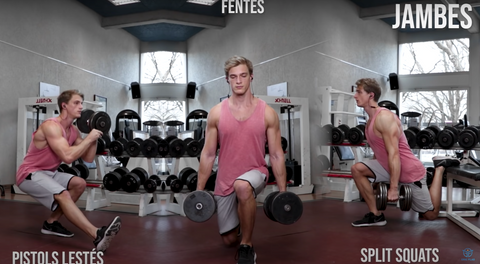Natural muscle gain: our best advice!
Hi, welcome to my little guide to gaining muscle. After writing an article on"How to succeed in Handstand and avoid potential mistakes" we want to talk about another topic today: that of gaining mass.
Honestly, it's pretty simple and I can even sum it up for you in one sentence: "To gain muscle naturally, your goal is to get stronger and stronger on the biggest exercises."
If that's all you're doing, you'll already be going very far. After that, of course, you have to break that down a little bit. We'll get into the exercises right after that and I'll even give you a full program at the end of this article. So yes, all this is simple, but it's not easy or obvious.
Structure your workouts for your muscle gain
Let's start with the structure of your workouts and specifically the range of reps you should be aiming for. This is the fairly standard and accepted chart that can help a lot in tying goals to the right range. I should point out that this is the chart for normal people because, as usual; the rules change if you are on the extremes.

Let's cut to the chase 👉 : for effective mass gain, I advise you to spend a minimum of 80% of your time and effort working on large polyarticular exercises for sets between 4 and 8 reps. If you wish, you can use the remaining 20% of your time and effort onisolation exercises or to build volume, and therefore longer sets.
A good workout will include four or five different exercises for 3 to 4 sets each. Always start your workouts with the most intense exercises in short sets, because they are the most important and you need to be fresh to do them.
Moreover, it is also because of their intensity that they will require more rest time between each set.
The goal is to get stronger and stronger, which will require, over the course of the workouts, to increase the intensity of these exercises to force your body and your muscles to adapt. And it is precisely to help it do this that you eat a surplus of calories. There are several ways to do this, but a simple and effective method is to use only the first two in the form of a double progression. (see below)

Here's the idea: you're going to aim to stay within a small range of reps for each exercise in your routine, and as soon as you reach the top of that range, you're going to bring the total weight up. For example, one exercise in the routine I give you next is: Weighted Dips for three sets of 4-6 reps. The first few times you do the exercise, you'll need to do a few trials to see how much you can do. But then it's simple, as soon as one of your sets reaches 6 reps, you increase the weight of your three sets at your next session.
The goal and if today I do 6, 5 and 4 reps at 50 pounds, at my next session I will go up to 17 and a half or 20 pounds my three sets. My reps will decrease accordingly and I can work my way back up to 6 reps and so on.
The best exercises for muscle gain
Now you need exercises to apply it to. And here is a list of the most common exercises efficient these are the ones I think you should choose from when creating your routines. I have separated them by major muscle groups. And we start with the pectorals with, of course, the bench press and inclined to the bar or dumbbells which, along with weighted dips, are the best exercises 👇


Push-ups can be a good exercise, but they are complicated to weight gradually, conveniently and sustainably 👆
Let's move on to the shoulders with the standing and sitting military press 👇

At body weight, the progression from pike push-ups to handstand push up, which you can even weight down afterwards, will help to make them bigger, just like your arms.


Finally, since the front of the shoulders is often used a lot, lateral and forward leaning lifts can help round out the sides and back.

We move on to the back with weighted pull-ups, of course, in pronation or suppination depending on what interests us most. You will find our weighted belt ideal for this.

We add the deadlift, an exercise in unparalleled brute force 💪

Horizontal pull-up with barbell or dumbbell.


For the lower body, there is obviously the free bar squat and its front variation.

The leg press, which is often seen.

Less commonly seen are weighted pistol squats, as well as split squats and barbell or dumbbell lunges.

In terms of insulation, why not curls machine and, of course, if you are concerned about the size of your calves you can make them sit at the press or stand at the bar.


For the trunk and the abs there are of course dozens of exercises, but in my opinion, these are more than enough to go around:
The leg lifts that you can also weight down.

Weighted crunches with a pulley.


We finish quickly with the arms which are in my opinion already very well worked with the exercises of body weight like the dips and handstand push up. But if you want to isolate your biceps or triceps my two favorite exercises are the curls at the bar and the extended triceps extensions which allow for progressive overloading.


So much for the exercises, as you can see, a lot of free weights, because to make a mass gain purely with the body weight without using weights or making ballast, it is possible, but it is slower. It's more complicated to set up, to measure and it's therefore less efficient in my opinion, and for the lower body, it's really very limited.
I'll go over a few more important points.
How often should I train to gain muscle?
For the frequency of training, in my opinion, 3 to 4 times a week is ideal, but it also depends on your job, your time and your recovery. Because recovery, i.e. everything you do outside of sport, is also very important. So, there is a part of genetics, yes, but there is also a big part over which you have some control, such as your nutrition, but also the quantity and quality of your sleep and your level of stress on a daily basis, to name the most important factors.
What about cardio?
So from a pure mass gain perspective, it's not very useful, but in moderate amounts, it's not a bad thing at all. And of course, you may need it for certain sports that you will do in parallel. After that, don't lie to yourself, being muscular and heavy doesn't help much to run far and long. So, it's up to you to know what your priority objective is.
A complete routine for muscle gain
We now move on to the complete routine that I have prepared for you and that concerns beginners and intermediates, that is to say almost everyone. It consists of two hard and fast sessions to be alternated with, if possible, at least one day of rest between each. As illustrated below, I recommend you to do it three times a week or possibly every other day. Here are the details of the two sessions of this routine.



This is pretty much the routine I did myself when I finally figured out how to train and it gave me great results. Of course, the purpose of this article was to help you create your own routine. So feel free to do so or modify this one, especially the isolation exercises according to your preferences or to focus more precisely on your weak points.
And there's another free and very popular free-weight program, Stronglift 5x5, which you can find out more about if you like. A final very important point is that in your workouts, you should always aim to do better than last time. So it's absolutely essential to know what you did last time, and always write down your performance at each session.
That's the end of this article, thank you for reading, I hope you find it useful. You can also watch the video on natural muscle gain.
See you soon, Eric




Leave a comment
This site is protected by reCAPTCHA, and Google's Privacy Policy and Terms of Service apply.